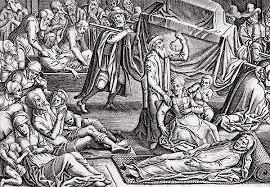Reign of Edward III 1327-1377
William de Hauberge became Rector in 1339, followed soon afterwards by Adam de Lynham in 1342, who stayed for 28 years. Adam stayed in Willingham much more than his predecessors. The fact that he left a breviary, cope and a full set of vestments to the Church was perhaps an indication of his affection for the place. There is perhaps another reason that kept Adam de Lynham in Willingham for so long – The Black Death.
The Black Death, or Bubonic Plague, arrived in England from Europe in 1348 through the ports .We now know the bacteria were spread by fleas carried on black rats, and it spread northwards at a terrifying speed. First symptoms were a blackened tongue, high fever and the rapid spread of boils across the whole body. Most died within one week. Few recovered. It affected rich and poor, peasants, and priests in equal measure, but in particular younger men and children. It seemed to disappear after 1349, but recurred in 1361-2.
Infected patients


The disease killed no less than 40% of the entire population of England. I can find no specific figures for Willingham (Parish records of births and deaths did not start until 1559), but we do know that 50% of the populations of Cottenham and Oakington died, so it is likely that deaths in Willingham would have been on a similar scale. On this basis, Willingham’s population of around 275 in 1340 would have fallen to barely 140. With half the village wiped out in such a short time, the effect on village life and work is difficult to imagine. In the diocese of Ely 350 out of 650 priests died. But Adam de Lynham, Rector of Willingham was not one of them. He lived through it all until 1375.
Norman Rectors
Willingham had a new Rector in 1370, Robert de Sustede. His name illustrates the continuing dominance of the Normans in English life, over 300 years after the Norman conquest. No fewer than eight of the first 12 Rectors of Willingham had names of French derivation. He was a Doctor of Law and was involved in the two Inquisitions which took place in Willingham in 1370 and 1371. These were held in the Bishop of Ely’s Manor House in Fen End. The Bishop of Ely still owned most of Willingham, as his predecessors had for 250 years. In 1370 he owned a windmill in Rampton Road (now no longer standing), and he also owned three fishponds known as Dernlode, Frithmere, and the Stacks. These fisheries played a very significant role in the Willingham economy of this period, providing employment and subsistence in fishing, fowling, and reed gathering.
The Rector goes to Rome
Robert de Sustede’s ability in law led to him being sent to Rome by King Edward III in 1371, to act for William de Wymondham, the King’s personal physician. We know that he started on his journey with a yeoman and two horses through the ports of London and Sandwich, and he is most likely to have followed the pilgrimage route of Via Francigena across France and over the Alps via the St. Bernard Pass. This distance was 1,100 miles and was known to have taken 12 to 14 weeks on horseback. In fact Robert died in Rome. One wonders whether he couldn’t face the journey back!
Next: The St. Christopher wallpainting
